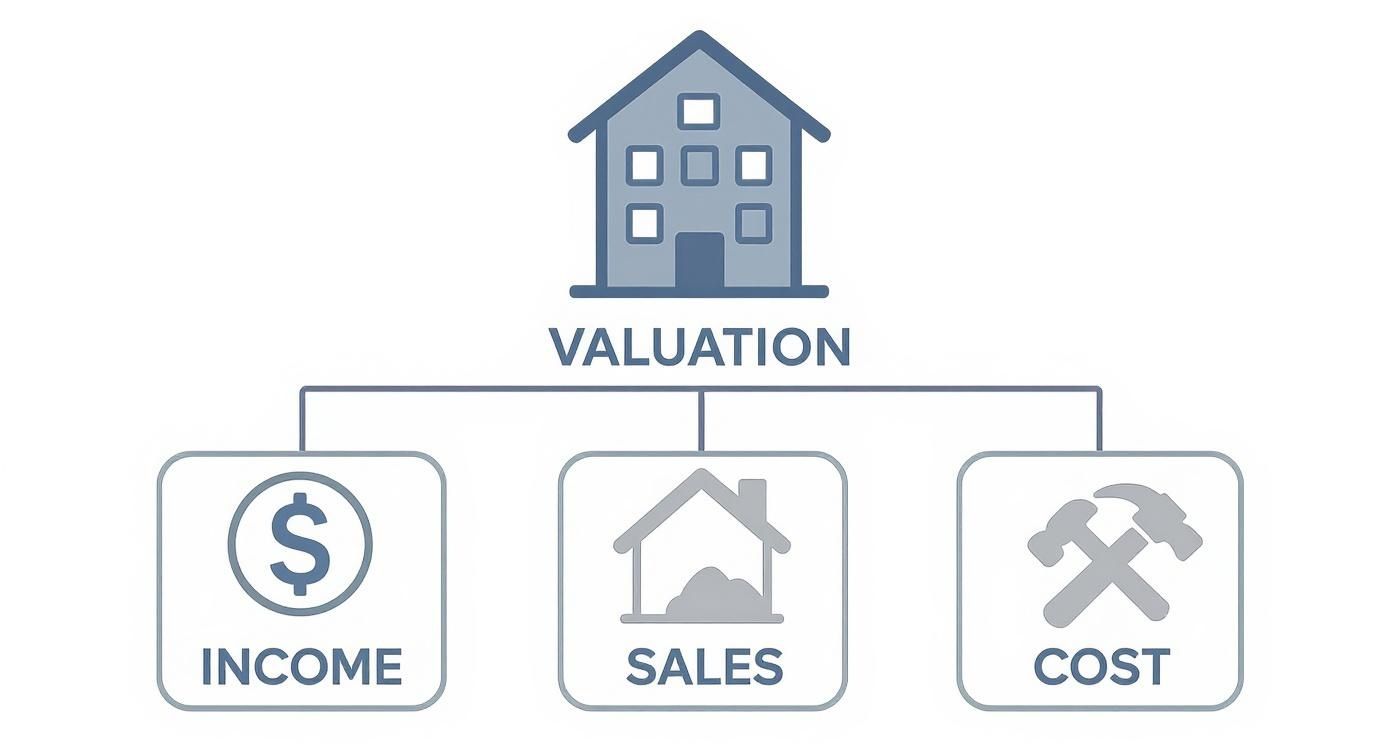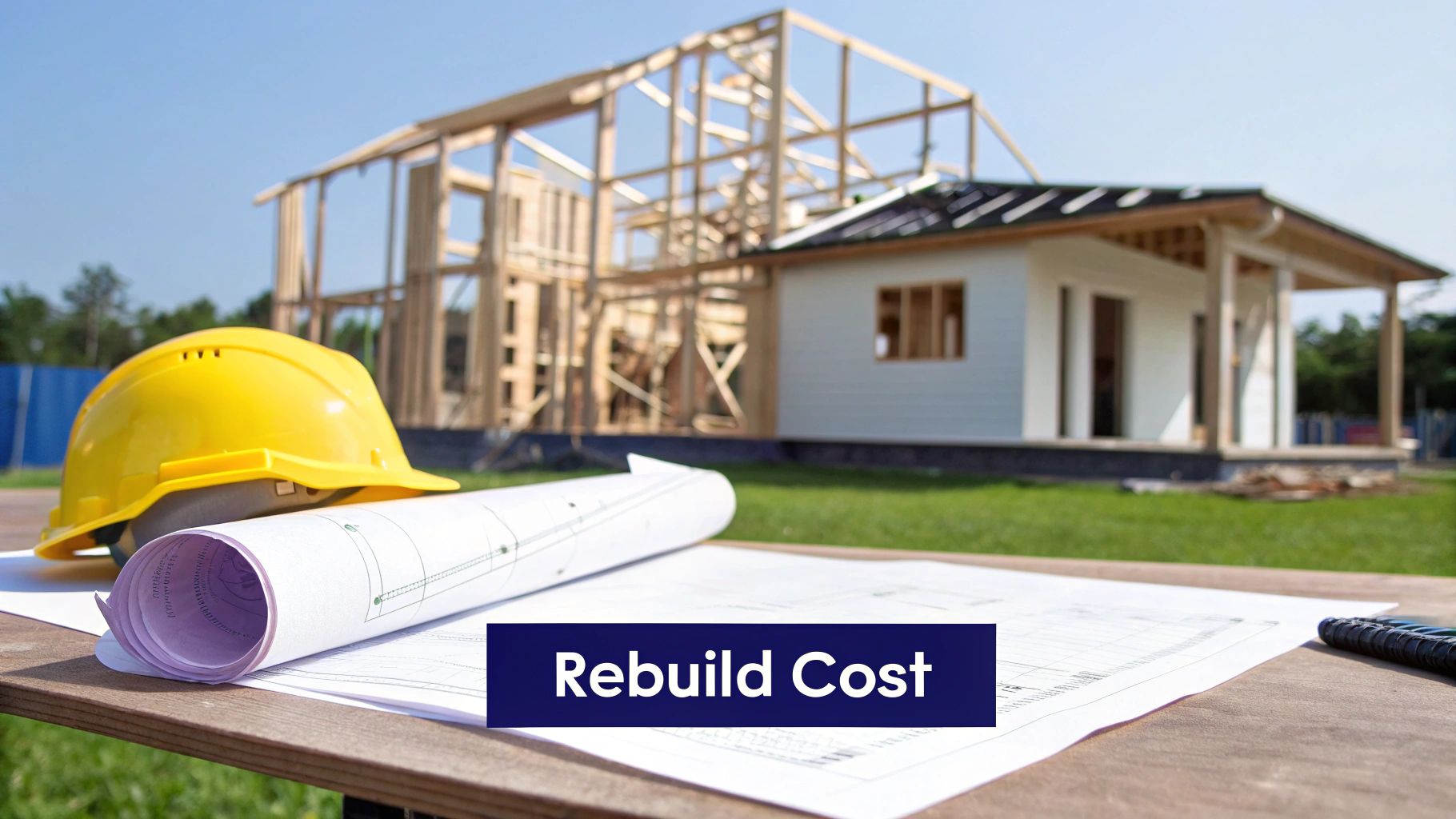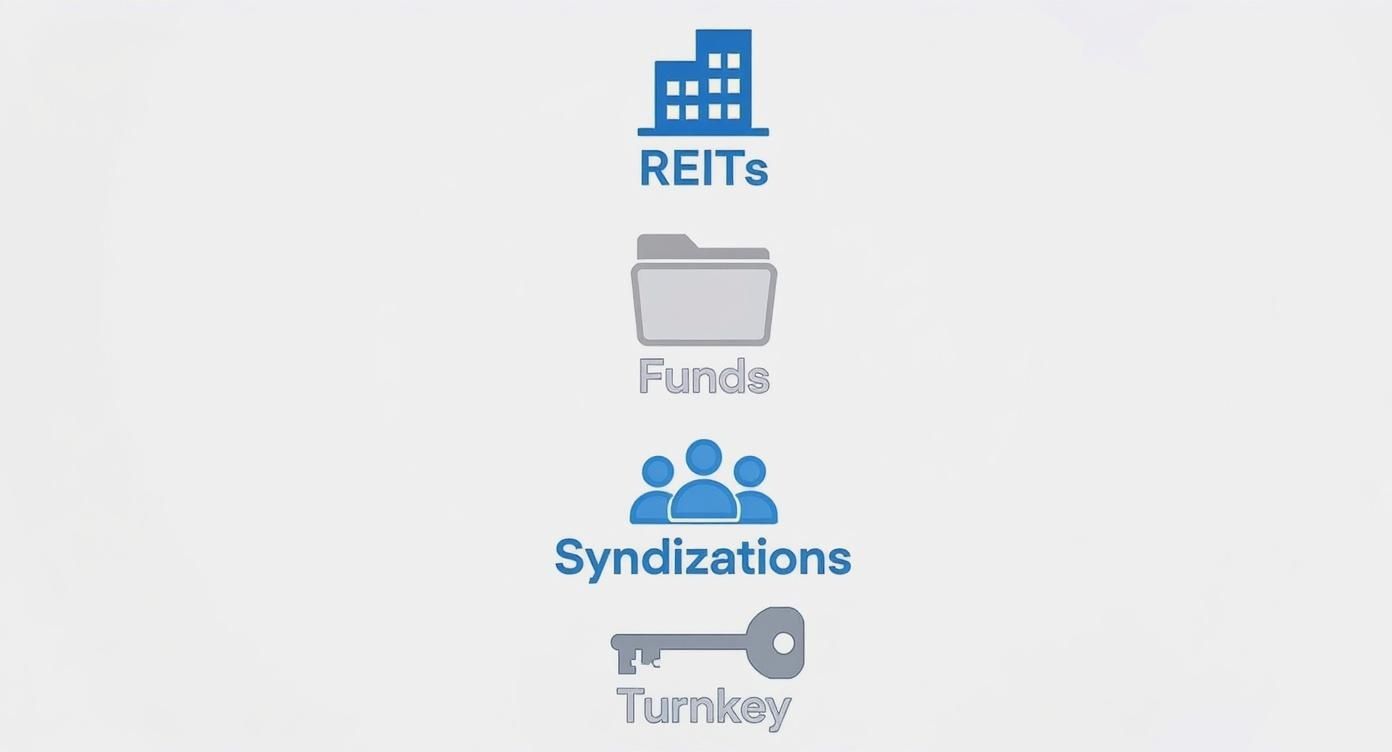Reading Time: 8 min | Good for: Novice (A), Informed (B), Sophisticated (C)
Ask any seasoned investor, and they'll tell you that finding a property's true worth is never about a single number spat out by a spreadsheet. The sharpest minds in real estate know it’s about triangulation—using three distinct, yet complementary, methods to build real conviction. These are the Income Approach, the Sales Comparison Approach, and the Cost Approach.
TL;DR: Three Lenses for One Clear Picture
Three Key Methods: Real estate valuation isn't a single formula; it's a disciplined process of blending the Income, Sales Comparison, and Cost approaches to arrive at a defensible value.
Why It Matters: Relying on one method is a rookie mistake that leads to overpaying or missing hidden potential. A multi-pronged analysis reveals the full story of an asset's strengths and weaknesses.
For the Investor: A sophisticated sponsor will always present a valuation that reconciles all three methods, clearly explaining how each one was weighted. This transparency is a hallmark of institutional-grade underwriting.
Why Real Estate Valuation Is Both Art and Science
Relying on just one valuation method can trick you into overpaying for an asset or, just as bad, underestimating its potential. A robust analysis means looking at a property from three different angles. It’s like valuing a business by looking at its profits, what its competitors recently sold for, and what it would cost to build the whole operation from scratch.
Each method tells a unique part of the property's story:
The Income Approach: This is all about the money. It views the property as a financial engine, focusing purely on the cash flow it can generate. For commercial assets like apartment buildings or data centers, this is king.
The Sales Comparison Approach: This one grounds your valuation in reality. It answers the simple, powerful question: "What have similar properties nearby actually sold for?" It’s your best defense against overly optimistic, pie-in-the-sky projections.
The Cost Approach: Here, you're asking what it would cost to build an identical property from scratch today. This is essential for new developments or for unique, specialized assets where you just can't find good "comps."
The goal isn't to get three identical numbers—in fact, they rarely match up perfectly. The real expertise comes from understanding why the values are different and then skillfully reconciling them into a single, defensible conclusion. This process forces you to dig deeper into the asset’s strengths, weaknesses, and where it truly sits in the market.
Sometimes, numbers on a page don't capture the full picture. Advanced tools like drone photography in real estate can provide critical context about a property's condition, location, and unique features that raw data alone will always miss.
Investor Takeaway: A sophisticated sponsor will never come to the table with a valuation based on a single approach. They’ll show their work across all three relevant methods, explaining exactly how they weighted each one to land on a final, considered opinion of value. It’s a clear sign of discipline and a deep understanding of the asset.
The infographic below breaks down these three core pillars of real estate valuation.

This simple hierarchy shows how the Income, Sales, and Cost methods form the bedrock of any solid valuation. By blending these different viewpoints, investors get a much more complete and reliable financial picture.
To help you see how these methods stack up, here’s a quick-reference summary comparing their core principles and primary applications.
At a Glance: Comparing the Three Valuation Approaches
Valuation Approach | Core Principle | Best Suited For | Key Metric |
|---|---|---|---|
Income Approach | A property's value is derived from the income it generates. | Commercial properties (apartments, offices, retail) | Net Operating Income (NOI), Cap Rate, Discount Rate |
Sales Comparison Approach | Value is determined by what similar properties have recently sold for. | Residential homes, condos, small commercial buildings | Price Per Square Foot, Price Per Unit, Recent Sale Prices |
Cost Approach | Value is the cost to replace the property (land + improvements) minus depreciation. | New construction, unique properties (churches, schools), insurance valuations | Replacement Cost New, Depreciation (physical, functional, external) |
As you can see, each approach offers a different lens. A smart investor knows how to use all three to build a comprehensive case for a property's value. Now, let’s walk through each of these critical valuation approaches one by one.
The Income Approach: How to Value Earning Potential
For most of us in commercial real estate, a property isn't just brick and mortar—it's a cash-generating engine. This is why the Income Approach is so critical. It cuts right to the chase and answers the single most important question: "Based on the money it produces, what is this property worth to an investor?"
To get to that answer, we use two primary methods. The first is Direct Capitalization, which gives us a powerful, at-a-glance valuation. The second, Discounted Cash Flow (DCF) analysis, offers a more dynamic, forward-looking view that’s essential for deals with a bit more hair on them.
Direct Capitalization: A Powerful Snapshot
The Direct Capitalization method is a straightforward way to turn a single year's income into a current value. It’s a back-of-the-napkin calculation that every serious investor needs to master, and it’s built on two core components: Net Operating Income (NOI) and the Capitalization Rate (Cap Rate).
Think of NOI as the property's annual profit before you factor in debt payments and income taxes. It's the pure, unadulterated cash the asset throws off after paying all its bills.
Novice Lens: What is NOI?NOI stands for Net Operating Income. It's calculated like this:* Gross Potential Income - Vacancy & Credit Loss = Effective Gross Income* Effective Gross Income - Operating Expenses = Net Operating Income (NOI)Why it matters: NOI is the purest measure of a property's profitability. It shows how much cash is left over to pay lenders and distribute to investors.
The Cap Rate is a market-driven number that tells you what investors are willing to pay for a dollar of NOI in a specific market, for a specific asset type. A lower cap rate means investors are paying more (implying lower risk), while a higher cap rate suggests they demand a better return for taking on more risk.
The formula is elegantly simple:
Property Value = Net Operating Income (NOI) / Capitalization Rate (Cap Rate)
This calculation is the bedrock of commercial real estate valuation. It gives you a quick, gut-check assessment of an asset’s worth based on its current performance and what the market thinks it’s worth.
Deal Lens Example: Illustrative Multifamily Asset
Let's run the numbers on a hypothetical 100-unit apartment building to see this in action. (Note: These numbers are simplified for illustrative purposes.)
Calculate Gross Potential Income: 100 units x $2,000/month average rent x 12 months = $2,400,000.
Factor in Vacancy: We’ll assume a 5% vacancy and credit loss rate. That’s $2,400,000 x 5% = $120,000.
Find Effective Gross Income: $2,400,000 - $120,000 = $2,280,000.
Subtract Operating Expenses: Let's assume expenses (management, taxes, insurance, maintenance) run at 35% of EGI. So, $2,280,000 x 35% = $798,000.
Calculate NOI: $2,280,000 - $798,000 = $1,482,000.
Apply the Cap Rate: If similar buildings in the neighborhood are trading at a 5.5% cap rate, our valuation is: $1,482,000 / 0.055 = $26,945,454
So, this quick math gives us a solid baseline value of right around $27 million.
Discounted Cash Flow (DCF): A More Dynamic Valuation
While Direct Capitalization is perfect for stabilized, predictable properties, it falls short when you're looking at a value-add or opportunistic deal. For assets where we plan to aggressively raise rents, slash expenses, or pump in capital for improvements, a static, one-year snapshot just doesn't tell the whole story.
This is where Discounted Cash Flow (DCF) analysis becomes our tool of choice.
DCF analysis projects a property’s cash flows over a specific hold period—usually 5 to 10 years—and includes the estimated sale price at the end. It then discounts all that future money back to what it's worth today. This "present value" is crucial because it’s built on a fundamental truth: a dollar today is worth more than a dollar you get tomorrow.
This method is definitely more complex, but it paints a much richer, more accurate picture of an investment’s true potential, especially for an asset that's about to undergo a transformation. It allows us to model the direct financial impact of our strategic plan, year by year.
For investors who want to go deeper, our detailed guide explains how to calculate a discounted cash flow for real estate success. This approach is absolutely essential for properly underwriting development and value-add projects where the future is designed to look very different from the present.
The Sales Comparison Approach: Finding Value in Market Truths
If the Income Approach tells you what a property should be worth based on its financial performance, the Sales Comparison Approach grounds that theory in cold, hard market reality. It gets right to the heart of any transaction by asking one simple question: "What are people actually paying for similar properties, right here, right now?"

Think of it like appraising a classic car. You can analyze its engine performance and historical significance (the Income Approach), but the truest measure of value is what similar models have recently sold for at auction. In real estate, this method is the ultimate reality check against overly optimistic spreadsheets.
The Sales Comparison Approach is so fundamental that it’s the go-to valuation method in residential real estate, forming the backbone of nearly every single-family home appraisal. The whole process hinges on analyzing "comps"—data from comparable sales—which are cherry-picked based on similarities in size, location, age, and condition. Appraisers then make a series of value adjustments to normalize the comparison.
Selecting and Adjusting Comparables
This might sound simple on the surface, but doing it right is an art form. It's not just about pulling up records of nearby properties that recently sold; it's about finding the right ones and skillfully adjusting for every little difference.
An analyst will hunt for three to five solid comps that have sold within the last six to twelve months. The entire goal is to create a true "apples-to-apples" comparison by making a series of meticulous adjustments.
Investor Takeaway: Adjustments are where the art meets the science. If a comparable property has a less desirable location or a ton of deferred maintenance, you make a positive adjustment to its sale price—adding value to make it equivalent to the property you're analyzing. On the flip side, if a comp has a brand-new roof that your subject property lacks, that requires a negative adjustment.
Common Adjustment Factors
The objective is always to adjust the comparable property's price until it's a mirror image of the subject property. The key dials we turn include:
Property Rights Conveyed: Was it a straightforward sale, or were there unusual lease terms involved?
Financing Terms: An all-cash deal might trade at a different price than one with creative seller financing.
Conditions of Sale: Was the seller in a tough spot (like a foreclosure), leading to a fire-sale price?
Market Conditions: If the market has jumped 5% since the comp sold, its price gets adjusted upward to reflect today's values.
Location: In real estate, a few blocks can feel like a different world—and a different price point.
Physical Characteristics: We make tweaks for everything from square footage and age to construction quality and amenities.
To nail the sales comparison approach, you need access to a mountain of fresh, reliable market data. The ability to efficiently gather real estate market data is what separates a good valuation from a great one, allowing for far more precise and defensible adjustments.
The Insight Edge: Using Comps Strategically
For a sponsor like Stiltsville Capital, the Sales Comparison Approach is more than just a valuation exercise—it’s a strategic weapon. By diving deep into the comps, we can spot market dislocations and validate the assumptions powering our entire financial model.
Let's say our Income Approach model spits out a value of $30 million for a property. But when we look at the market, we see that nearly identical buildings are consistently trading for $35 million. That's not just a number; it's a huge signal. It tells us the property is likely mismanaged or undercapitalized, and our value-add plan has a clear, market-proven upside.
On the other hand, if comps are trading well below our income-based valuation, that’s a major red flag. It’s the market telling us our rent growth projections or expense assumptions might be way too aggressive. This method keeps our underwriting honest and tethered to reality, protecting investor capital from speculative bets. It ensures our pro forma isn’t just a theoretical exercise but a reflection of achievable, real-world value.
The Cost Approach: Determining What It Takes to Rebuild
What happens when you’re looking at a property that’s one-of-a-kind? Maybe it’s a brand-new build with zero income history, or a specialized building like a data center with no real market "comps." This is where the Cost Approach steps in. It’s a valuation method that answers one simple, powerful question: What would it cost to build this exact property from scratch today?

This approach is our go-to for unique properties like schools or government buildings, and it's essential for any new construction deal. It also creates a logical ceiling on a property's value. After all, a sharp investor is never going to pay more for an existing building than it would cost to build a modern, more efficient equivalent right next door.
The formula itself is pretty straightforward:
Property Value = Replacement Cost New - Accrued Depreciation + Land Value
Let’s pull back the curtain on each piece of that equation.
Replacement Cost vs. Reproduction Cost
There's a critical distinction to make right off the bat, and it’s not just industry jargon—it has a real impact on your valuation.
Replacement Cost: This is the price tag for building a structure with the same usefulness using today’s materials, design, and standards. Think replacing old plaster walls with modern drywall—same function, different (and likely cheaper) method.
Reproduction Cost: This is the cost to build an exact duplicate of the building, warts and all. This includes outdated materials and quirky design flaws, making it most useful for historic properties where authenticity is key.
For nearly all commercial real estate deals, replacement cost is what matters. It gives you a practical, real-world number for creating a functionally equivalent asset in the current market. We often lean on services like RSMeans or Marshall & Swift, which provide detailed construction cost data. And it's not just about materials; modern techniques like those discussed in our guide to modular construction can drastically change these estimates.
Understanding the Three Types of Depreciation
In the Cost Approach, "depreciation" isn't the number you give your accountant. It's the tangible, real-world loss in value an asset experiences over time. A building is simply worth less than its brand-new replacement because of wear and tear, outdated features, or even what’s happening down the street. We break this "accrued depreciation" into three buckets.
Physical Deterioration: This is the easy one. It’s the visible wear and tear from age and use—a leaky roof, a cracked parking lot, an HVAC system on its last legs. Some of it is curable (it makes economic sense to fix), while some is incurable (the repair costs more than the value it adds).
Functional Obsolescence: This is about a loss in value from outdated design. Picture an old office building with ceilings so low you feel like a giant, or one with electrical systems that can't handle a modern tech company's needs. The building still stands, but it just doesn't work for today's tenants.
External Obsolescence: This value-killer comes from factors completely outside the property line, which means it's almost always incurable. This could be a new highway interchange that brings constant noise, a major local employer packing up and leaving town, or a zoning change that hurts the property's highest and best use.
### Novice Lens: Why the Cost Approach Sets a Value CeilingIf you're new to valuation, think of it like this: Why would you pay $10 million for a 10-year-old warehouse when you could build a brand-new, more efficient one on the empty lot next door for $9.5 million?You wouldn’t. The cost to build from the ground up puts a cap on what any rational buyer would pay for an existing property. That makes this approach an indispensable reality check, especially when you're underwriting development or redevelopment deals.
Synthesizing the Methods: The Art of Final Reconciliation
Running the numbers for three different valuation methods is just the warm-up. The main event—and where true expertise really comes into play—is the final reconciliation. This is where an analyst moves from spreadsheets to strategy, artfully weighing the results from each approach to land on a single, defensible value.

This isn’t about just averaging the three numbers. Far from it. The weighting is a deliberate, strategic decision that reflects the nature of the property and the quality of the data you have to work with. A disciplined sponsor will always give the most weight to the method that best mirrors how a typical buyer would think about that specific type of property.
Weighting Based on Asset Type and Strategy
Understanding the logic behind this weighting is crucial. The right blend of valuation approaches changes completely depending on the deal.
For a stabilized, income-producing office building: The Income Approach might get a 70% weighting. Anyone buying this asset is primarily buying a predictable stream of cash flow. The Sales Comparison Approach would get maybe 25% as a reality check against the market, with the Cost Approach getting a token 5%.
For a brand-new data center development: The Cost Approach could command a 60% weighting. With no income history and few, if any, direct sales comps, the cost to build it from scratch is the most reliable starting point. The Income Approach (based on projected lease-up) might get 40%, with the Sales Comparison Approach at 0% because relevant data just doesn't exist.
For a single-family home: The Sales Comparison Approach is king, often weighted at 85% or more. This market is all about what similar homes down the street have sold for, making recent comps the most powerful indicator of value.
Investor Takeaway: Reconciliation isn't just a final math problem; it's a narrative. It tells the story of why a property is valuable and how a potential buyer is most likely to see that value. A sponsor’s weighting choices reveal their core thesis for the investment.
For a deeper dive into how these final figures contribute to the ongoing assessment of an investment's worth, check out our guide to real estate net asset value, a clear look at what your investment is truly worth. This concept builds directly on the reconciled value we establish during underwriting.
Investor Checklist: Questions to Ask a Sponsor About Valuation
To help you pressure-test any deal, here are the critical questions to ask about the valuation and reconciliation process. A good sponsor will have thoughtful, data-backed answers ready.
Which valuation approach did you weight most heavily, and why, specifically?
Can you walk me through your top three comps for the Sales Comparison Approach?
What specific adjustments did you make to those comps, and how did you quantify them?
In your DCF model, what are the key assumptions driving your projected NOI growth and terminal value?
What exit cap rate are you assuming, and how does that compare to the going-in cap rate and current market rates?
For the Cost Approach, where did you source your replacement cost data, and how did you calculate depreciation?
How does your final valuation compare to the initial asking price?
What are the biggest risks to your valuation assumptions?
Common Questions on Real Estate Valuation
Even after getting a handle on the three core valuation methods, a few specific questions always seem to pop up. Let's tackle some of the most common ones we hear from investors to make these concepts crystal clear.
Which Valuation Approach Is Most Important For Commercial Real Estate?
For income-producing properties like an apartment complex or a data center, the Income Approach is almost always the star of the show. Investors buy these assets for the cash they generate, which makes Direct Capitalization and Discounted Cash Flow (DCF) models the bedrock of any serious underwriting.
That said, the Sales Comparison Approach is still vital. It acts as a reality check, ensuring our income-based value isn’t out of sync with what similar properties are actually trading for in the market. The Cost Approach gets less stage time for stable, existing assets but is indispensable for new construction or for niche properties, like a specialized lab, where good comps are hard to find.
How Does A Property's Condition Impact Its Valuation?
A property's physical condition is a massive factor that ripples through all three valuation methods. You can't ignore it.
Sales Comparison Approach: An appraiser will make direct dollar adjustments. A leaky roof means subtracting value, while a brand-new lobby adds value right back in.
Income Approach: Bad condition means you can't charge top-dollar rents, you'll likely have more vacancies, and your repair budget will be higher. All of these hit your Net Operating Income (NOI) directly, which in turn lowers the property's value.
Cost Approach: Here, poor condition is literally calculated as "physical deterioration." It's a specific type of depreciation that reduces the property's value from what it would cost to build it new today.
What Is The Difference Between Valuation And Price?
This is a critical distinction every investor needs to get right. ‘Valuation’ is what our analysis says a property should be worth. It's an estimate based on hard data, proven methods, and logical assumptions about the future—it's the intrinsic value.
‘Price’, on the other hand, is simply what someone actually pays for it. A solid valuation is your guide during negotiations, but the final price can be swayed by anything from a seller in a hurry to a bidding war. The goal for any sharp investor is to buy an asset at a market price that is below its carefully calculated intrinsic valuation.
Investor Takeaway: Never confuse what's on your spreadsheet with what the market will actually pay. The gap between valuation and price is where savvy sponsors find the real opportunities.
Why Do Different Appraisers Arrive At Different Values?
Valuation is part science, part art. Two perfectly competent appraisers can look at the same property and come up with slightly different numbers. Why?
They might choose different comparable sales, apply slightly different adjustments, or forecast different rent growth rates in their DCF model. Even picking a cap rate is an educated guess based on market data, and that can vary. This is exactly why sophisticated investors don't just look at the final number; they dig into the sponsor's assumptions to understand the story behind the valuation.
Understanding these valuation approaches is the first step toward making informed, confident investment decisions. We believe that well-structured real estate assets, underwritten with discipline, can be a prudent and resilient component of a long-term wealth strategy. At Stiltsville Capital, we combine rigorous, multi-faceted analysis with deep market knowledge to identify and execute on high-potential commercial real estate opportunities.
If you are an accredited investor interested in learning more about our disciplined approach and current offerings, we invite you to schedule a confidential call with our team.
Information presented is for educational purposes only and does not constitute an offer to sell or a solicitation of an offer to buy securities. Any offering is made only through definitive offering documents (e.g., private placement memorandum, subscription agreement) and is available solely to investors who meet applicable suitability standards, including “Accredited Investor” status under Rule 501 of Regulation D. Investments in private real estate involve risk, including loss of capital, illiquidity, and no guarantee of distributions. Past performance is not indicative of future results. Verification of accredited status is required for participation in Rule 506(c) offerings.











